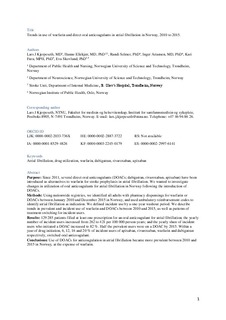Trends in use of warfarin and direct oral anticoagulants in atrial fibrillation in Norway, 2010 to 2015
Kjerpeseth, Lars Jøran; Ellekjær, Hanne; Selmer, Randi; Ariansen, Inger Kristine; Furu, Kari; Skovlund, Eva
Journal article, Peer reviewed
Accepted version
Permanent lenke
http://hdl.handle.net/11250/2450895Utgivelsesdato
2017Metadata
Vis full innførselSamlinger
Sammendrag
Purpose
Since 2011, several direct oral anticoagulants (DOACs; dabigatran, rivaroxaban, apixaban) have been introduced as alternatives to warfarin for stroke prophylaxis in atrial fibrillation. We wanted to investigate changes in utilization of oral anticoagulants for atrial fibrillation in Norway following the introduction of DOACs.
Methods
Using nationwide registries, we identified all adults with pharmacy dispensings for warfarin or DOACs between January 2010 and December 2015 in Norway, and used ambulatory reimbursement codes to identify atrial fibrillation as indication. We defined incident use by a 1-year washout period. We describe trends in prevalent and incident use of warfarin and DOACs between 2010 and 2015, as well as patterns of treatment switching for incident users.
Results
One hundred twenty-nine thousand two hundred eighty-five patients filled at least one prescription for an oral anticoagulant for atrial fibrillation; the yearly number of incident users increased from 262 to 421 per 100,000 person-years; and the yearly share of incident users who initiated a DOAC increased to 82%. Half the prevalent users were on a DOAC by 2015. Within a year of drug initiation, 6, 12, 16 and 20% of incident users of apixaban, rivaroxaban, warfarin and dabigatran, respectively, switched oral anticoagulant.
Conclusions
Use of DOACs for anticoagulation in atrial fibrillation became more prevalent between 2010 and 2015 in Norway, at the expense of warfarin.
